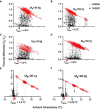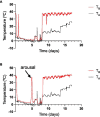Heterothermy as the Norm, Homeothermy as the Exception: Variable Torpor Patterns in the South American Marsupial Monito del Monte (Dromiciops gliroides)
- PMID: 34322034
- PMCID: PMC8311349
- DOI: 10.3389/fphys.2021.682394
Heterothermy as the Norm, Homeothermy as the Exception: Variable Torpor Patterns in the South American Marsupial Monito del Monte (Dromiciops gliroides)
Abstract
Hibernation (i.e., multiday torpor) is considered an adaptive strategy of mammals to face seasonal environmental challenges such as food, cold, and/or water shortage. It has been considered functionally different from daily torpor, a physiological strategy to cope with unpredictable environments. However, recent studies have shown large variability in patterns of hibernation and daily torpor ("heterothermic responses"), especially in species from tropical and subtropical regions. The arboreal marsupial "monito del monte" (Dromiciops gliroides) is the last living representative of the order Microbiotheria and is known to express both short torpor episodes and also multiday torpor depending on environmental conditions. However, only limited laboratory experiments have documented these patterns in D. gliroides. Here, we combined laboratory and field experiments to characterize the heterothermic responses in this marsupial at extreme temperatures. We used intraperitoneal data loggers and simultaneous measurement of ambient and body temperatures (T A and T B, respectively) for analyzing variations in the thermal differential, in active and torpid animals. We also explored how this differential was affected by environmental variables (T A, natural photoperiod changes, food availability, and body mass changes), using mixed-effects generalized linear models. Our results suggest that: (1) individuals express short bouts of torpor, independently of T A and even during the reproductive period; (2) seasonal torpor also occurs in D. gliroides, with a maximum bout duration of 5 days and a mean defended T B of 3.6 ± 0.9°C (one individual controlled T B at 0.09°C, at sub-freezing T A); (3) the best model explaining torpor occurrence (Akaike information criteria weight = 0.59) discarded all predictor variables except for photoperiod and a photoperiod by food interaction. Altogether, these results confirm that this marsupial expresses a dynamic form of torpor that progresses from short torpor to hibernation as daylength shortens. These data add to a growing body of evidence characterizing tropical and sub-tropical heterothermy as a form of opportunistic torpor, expressed as daily or seasonal torpor depending on environmental conditions.
Keywords: Dromiciops gliroides; Microbiotheria; heterothermia; hibernation; non-Holarctic heterotherms; passive cooling; torpor.
Copyright © 2021 Nespolo, Mejías, Espinoza, Quintero-Galvis, Rezende, Fontúrbel and Bozinovic.
Conflict of interest statement
The authors declare that the research was conducted in the absence of any commercial or financial relationships that could be construed as a potential conflict of interest.
Figures








Similar articles
-
Body Composition and Energy Savings by Hibernation: Lessons from the South American Marsupial Dromiciops gliroides.Physiol Biochem Zool. 2022 May-Jun;95(3):239-250. doi: 10.1086/719932. Physiol Biochem Zool. 2022. PMID: 35443149
-
Bioenergetics of torpor in the microbiotherid marsupial, monito del monte (Dromiciops gliroides): the role of temperature and food availability.J Comp Physiol B. 2010 Jun;180(5):767-73. doi: 10.1007/s00360-010-0449-y. Epub 2010 Feb 18. J Comp Physiol B. 2010. PMID: 20165853
-
Torpor-responsive microRNAs in the heart of the Monito del monte, Dromiciops gliroides.Biofactors. 2023 Sep-Oct;49(5):1061-1073. doi: 10.1002/biof.1976. Epub 2023 May 23. Biofactors. 2023. PMID: 37219063
-
Field evidence for a proximate role of food shortage in the regulation of hibernation and daily torpor: a review.J Comp Physiol B. 2014 Aug;184(6):683-97. doi: 10.1007/s00360-014-0833-0. Epub 2014 May 22. J Comp Physiol B. 2014. PMID: 24850375 Review.
-
Seasonal Expression of Avian and Mammalian Daily Torpor and Hibernation: Not a Simple Summer-Winter Affair†.Front Physiol. 2020 May 20;11:436. doi: 10.3389/fphys.2020.00436. eCollection 2020. Front Physiol. 2020. PMID: 32508673 Free PMC article. Review.
Cited by
-
Climate change and population persistence in a hibernating marsupial.Proc Biol Sci. 2024 Jun;291(2025):20240266. doi: 10.1098/rspb.2024.0266. Epub 2024 Jun 26. Proc Biol Sci. 2024. PMID: 38920109 Free PMC article.
-
Communal nesting is the optimal strategy for heat conservation in a social marsupial: lessons from biophysical models.J Exp Biol. 2022 Nov 15;225(22):jeb244606. doi: 10.1242/jeb.244606. Epub 2022 Nov 25. J Exp Biol. 2022. PMID: 36420835 Free PMC article.
-
The ecology and evolution of the monito del monte, a relict species from the southern South America temperate forests.Ecol Evol. 2022 Mar 1;12(3):e8645. doi: 10.1002/ece3.8645. eCollection 2022 Feb. Ecol Evol. 2022. PMID: 35261741 Free PMC article. Review.
-
Modeling heterothermic fitness landscapes in a marsupial hibernator using changes in body composition.Oecologia. 2023 Oct;203(1-2):79-93. doi: 10.1007/s00442-023-05452-4. Epub 2023 Oct 5. Oecologia. 2023. PMID: 37798536 Free PMC article.
-
Possible spread of SARS-CoV-2 in domestic and wild animals and body temperature role.Virus Res. 2023 Apr 2;327:199066. doi: 10.1016/j.virusres.2023.199066. Epub 2023 Feb 10. Virus Res. 2023. PMID: 36754290 Free PMC article. Review.
References
-
- Bates B., Maechler M., Bolker B. (2013). lme4: linear mixed-effects models using S4 classes. R package Version 0.999375-39. Available at: http://CRAN.R-project.org/package=lme4
-
- Boyles J. G., Storm J. J., Brack V. (2008). Thermal benefits of clustering during hibernation: a field test of competing hypotheses on Myotis sodalis. Funct. Ecol. 22, 632–636. 10.1111/j.1365-2435.2008.01423.x - DOI
-
- Bozinovic F., Contreras L., Rosenmann M., Torres-Mura J. C. (1985). Bioenergética de myotis chiloensis (quiroptera: vespertilionidae). Rev. Chil. Hist. Nat. 58, 39–45.
-
- Bozinovic F., Marquet P. A. (1991). Energetics and torpor in the Atacama desert-dwelling rodent Phyllotis darwini rupestris. J. Mammal. 72, 734–738. 10.2307/1381835 - DOI
LinkOut - more resources
Full Text Sources

